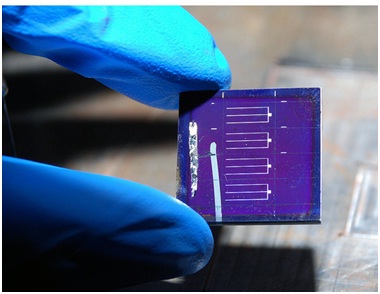Working with two Asia-based firms, IBM (News  - Alert) has developed CZTS thin-film solar systems that are capable of achieving a PV solar-to-electric power conversion efficiency of 11.1 percent— a world record for this class of semiconductors. What’s more, they can be manufactured using simple, ink-based techniques, including printing and casting.
- Alert) has developed CZTS thin-film solar systems that are capable of achieving a PV solar-to-electric power conversion efficiency of 11.1 percent— a world record for this class of semiconductors. What’s more, they can be manufactured using simple, ink-based techniques, including printing and casting.
In a recent blog, authored by IBM Research photovoltaic scientists, the company notes that, of the numerous existing PV technologies developed to date, none has combined the virtues of being:
- Highly efficient
- Cheaply scalable
- Made with abundantly available materials
IBM’s Materials Science team partnered with Solar Frontier, a Tokyo-based manufacturer of CIS (copper, indium, selenium) thin-film solar modules; and DelSolar, a developer of solar cells and modules and PV systems with headquarters in Taiwan; to develop an efficient and affordable PV cell made of abundant natural resources.

Image via www.ibm.com
So far, the tests of the prototype Cu2ZnSn(S,Se)4 (made of readily available copper, zinc, and tin, and referred to as CZTS) thin-film devices out-achieve the performance of crystalline silicon PV semiconductors, which currently are in widespread use—in everything from home electronics to the International Space Station. Although the crystalline silicon semiconductors are abundant and highly efficient, the scientists say that they have “extremely high material purity requirements (>99.9999 percent!), and the wafers are typically cut from large solid ingots and wired in series to form PV modules – making the process expensive and difficult to [scale up].”
Other thin-film chalcogenide materials used in PV cells, such as Cu (In, Ga)(SSe)2 (CIGS) and CdTe, have been developed to a performance level close to that of silicon, with inherently more scalable processing. They are directly deposited on large-area, low-cost substrates, such as glass, metal or plastic foil. While CIGS and CdTe are easy to integrate into buildings and consumer products, their compounds contain rare and expensive elements that increase cost and limit their manufacturing levels to less than 100 gigawatts per year. (Worldwide continuous electricity consumption is 15 terawatts – 150 times greater than the level of what these CIGS can produce).
IBM’s new CZTS PV cells could potentially yield up to 500 GW per year —“approaching the terawatt levels of renewable electricity the planet needs.”
The focus of the triple-threat development team, according to IBM, “remains to further increase this device efficiency and transfer the technology to environmentally-friendly, high-throughput industrial manufacturing. The hope is that within several years this new class of photovoltaic materials will begin to contribute to the wider availability of lower-cost solar electricity.”
Want to learn more about the latest in communications and technology? Then be sure to attend ITEXPO West 2012, taking place Oct. 2-5, in Austin, TX. Stay in touch with everything happening at ITEXPO (News - Alert). Follow us on Twitter.
Edited by Brooke Neuman
 Internet Telephony Magazine
Click here to read latest issue
Internet Telephony Magazine
Click here to read latest issue CUSTOMER
CUSTOMER  Cloud Computing Magazine
Click here to read latest issue
Cloud Computing Magazine
Click here to read latest issue IoT EVOLUTION MAGAZINE
IoT EVOLUTION MAGAZINE




